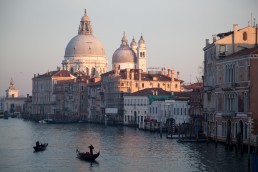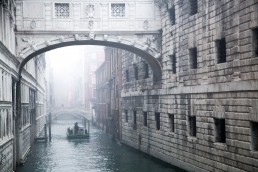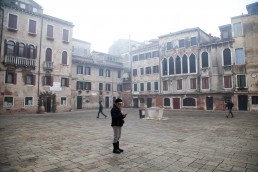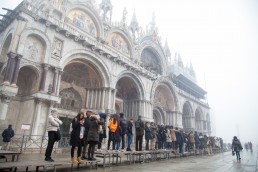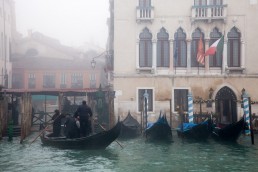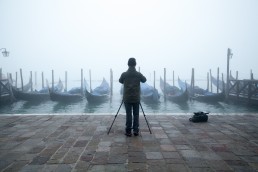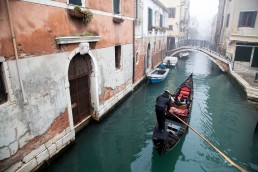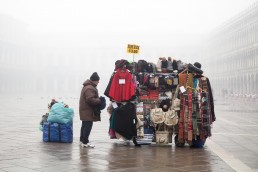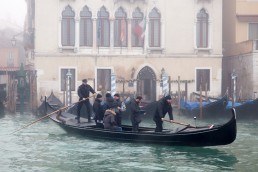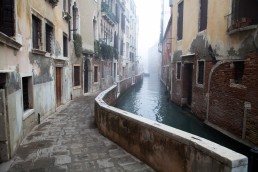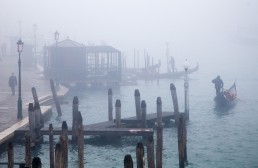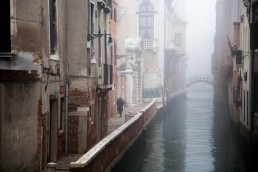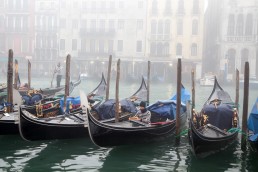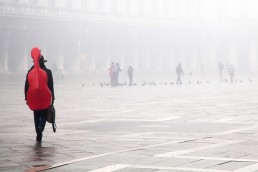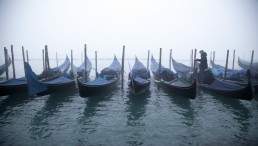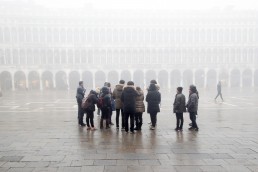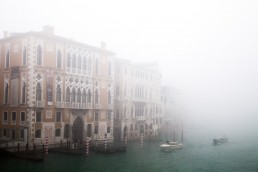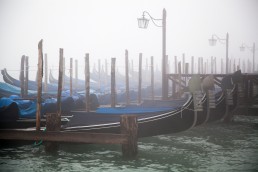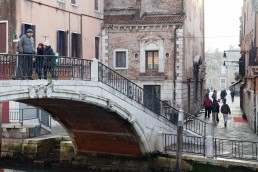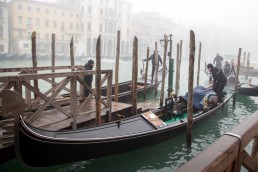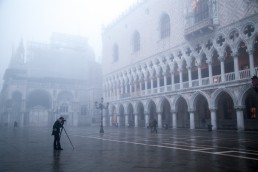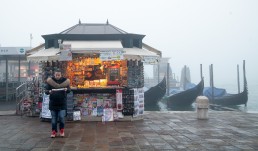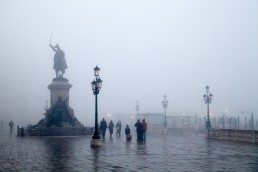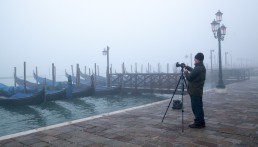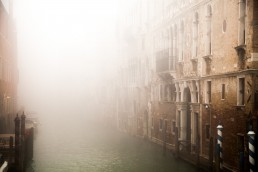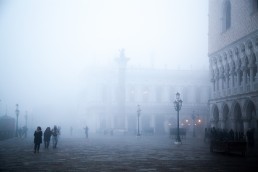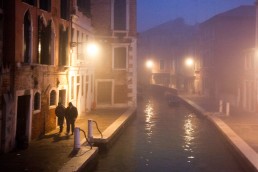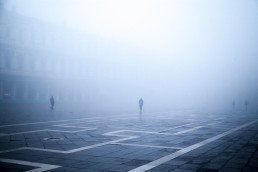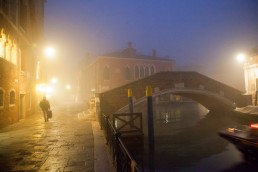Poet Joseph Brodsky picked the perfect season in which to fall in love with Venice. Every winter, the Queen of the Adriatic becomes a hazy, horde-free watercolour. And you’ll have no trouble getting a seat at Harry’s Bar.
NOBEL LAUREATE JOSEPH Brodsky adored Venice. So much so that, starting in the early 1970s, he dropped in on the Italian lagoon city every year for 17 years, enigmatically describing his buoyant Eden as being “like Greta Garbo swimming”.
It was a place where, the Russian poet said, he could all but disappear, becoming “a small moving dot in that gigantic watercolour”.
Brodsky added, “I would never come here in summer, not even at gunpoint.”
ADMIRED FOR CENTURIES for its prosperity, political stability and can-do swagger, the Republic of Venice was historically nicknamed la Serenissima, or “the most serene”. Today, with more than 20 million visitors schlepping up and down its narrow alleyways and over its arched bridges each year, applauding Venice for tranquillity is like commending Hong Kong as a travel bargain.
Usually stuffed to the gills (the perfect phrase — Venice is shaped, after all, like a fat fish), the watery wonderland is currently in crisis. Barely a month goes by without the remaining Venetians (there are now fewer than 50,000 permanent residents — about the same number as after the Great Plague of 1348) protesting at the shoddy treatment of their unique and fragile hometown.
In September of this year, Venetians dressed as pirates took to small boats to confront the leviathan-like cruise ships that disgorge bovine hordes day after day. Weeks later, they lugged suitcases across town to symbolise how high prices were forcing them to leave.
While Venice’s glitzy film festival celebrates the city, concerned directors now make doom-laden documentaries about the place — critically acclaimed The Venice Syndrome has been described as a “portrait of a city in the process of destroying itself”.
In short, visit Venice in the early 21st century and you might head home not only with Venetian-glassware souvenirs more likely fired in Suzhou than Murano, but also weighed down by guilt.
THE REPROACH-FREE trick, of course, is to do like Brodsky: alight on Venice in winter, there to be greeted only by “the smell of freezing seaweed”, which he declared synonymous with “utter happiness”. And what better guidebook than Watermark, Brodsky’s petite yet poignant paean to the strained Queen of the Adriatic.
Watermark won’t tell you which chichi boutique hotel overlooking the Grand Canal is currently in with the luxe-loving crowd, but it does describe how “in winter you wake up in this city, especially on Sundays, to the chiming of its innumerable bells, as though behind your gauze curtains a gigantic china tea set were vibrating on a silver tray in the pearl-grey sky.
“You fling the window open and the room is instantly flooded with this outer, peal-laden haze, which is part damp oxygen, part coffee and prayers.”
Brodsky would always visit Venice in December. This less-accomplished writer prefers January (any time, in fact, between New Year and the witless pantomime that is Carnevale). This is when Venice exhales, scrubs off the fake tan and reveals itself.
Without the crowds, suddenly Venice is romantic, magical, mysterious — all that you hoped for. And Venice in January is at its most affordable, with room rates halved — at least — from high season.
BUT WHAT TO SEE in winter that cannot be appreciated in summer? Well, just about everything made visible by the sun: Venice’s weakened and hazy January light has a pleasingly cinematic quality (think Nicholas Roeg’s spooky and dread-filled 1973 film Don’t Look Now). Fog rolls in, edges blur, buildings disappear, and sea and sky merge.
“On days like this,” Brodsky wrote, “the city indeed acquires a porcelain aspect, what with all its zinc-covered cupolas resembling teapots or upturned cups, and the tilted profile of campaniles clinking like abandoned spoons and melting in the sky.”
Stumble upon St Mark’s Square in reality-dissolving fog and the brain fails to compute: ‘This can’t be St Marks; where are the people?’
Like light, sound also becomes puzzling in winter (footsteps bounce and echo and amplify) and getting lost — a common entertainment at any time of the year in labyrinthine Venice — takes on a mind-bending new twist.
Stumble upon St Mark’s Square in reality-dissolving fog and the brain fails to compute: “This can’t be St Mark’s; where are the people?”.
And how many of us, when visiting Venice in summer, have quickly given up on the lovely idea of sinking bellinis like Ernest Hemingway — or chowing down on Scampi Thermidor alla Cipriani like fellow writer Jan Morris (her fave Venetian dish, apparently) — at Harry’s Bar because the landmark eatery was too (and here’s that perfect phrase again) stuffed to the gills?
Pop along in January and you’ll get a top-dollar table by the window.
What’s more, the hole-in-the-wall bàcari (taverns serving up Venetian-style tapas called cicchetti) favoured by rough-and-ready stallholders from Rialto Market also suddenly have space for an outsider or two.
Believed to be the oldest bàcaro in Venice, cramped Cantina Do Mori dates back to 1462. Casanova was a regular, they say. Try the vinegar-marinated anchovies, the creamed cod and the house speciality of francobollo (“postage stamp”) sandwiches.
SPEAKING OF CASANOVA, the legendary lover was addicted — or so the legend has it — to hot chocolate. The indulgent Venetian variety of the supposed aphrodisiac that’s served at Caffè Florian (established 1720), just off St Mark’s, is richer than you’ll find anywhere else and welcome when a pale and bone-chilling wind roars down from the Dolomites.
And then there’s the vexing acqua alta (literally, the “high water” and common in winter), when tides become cruel, canals overflow and St Mark’s can be knee-deep.
Not to worry: simply buy yourself a stripy scarf to fend off the chill (yes, there is now an official gondolier-clothing shop, approved by the Gondoliers of Venice Association, right next to Rialto Bridge) and splash along to bookshop Libreria Acqua Alta to browse the second-hand volumes piled high in bathtubs and row-boats to protect them from floods.
The offbeat store is, of course, the perfect place to grab your copy of Watermark, there to ponder Brodsky’s view that Venice should be seen as a living, breathing town with a working future.
“This city doesn’t qualify to be a museum,” the Russian insisted, “being itself a work of art, the greatest masterpiece our species produced. You don’t revive a painting, let alone a statue. You leave them alone, you guard them against vandals, whose hordes may include yourself.” ◉
This travel story ran in Post Magazine in 2016. Download PDF.
SHARE


